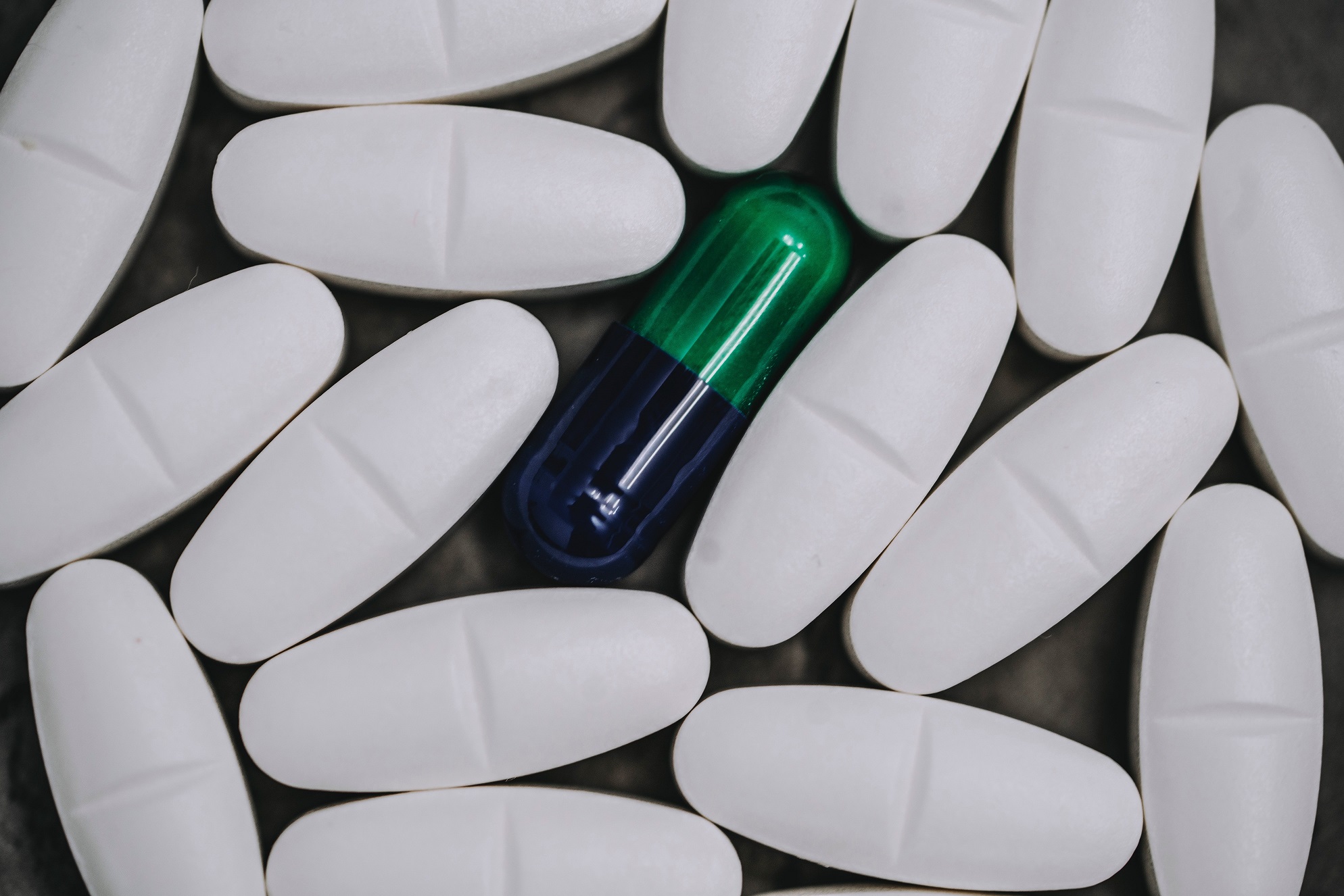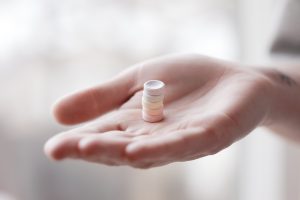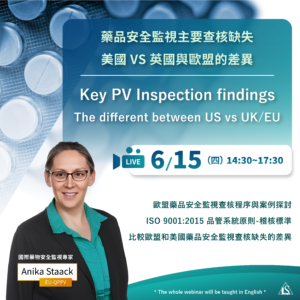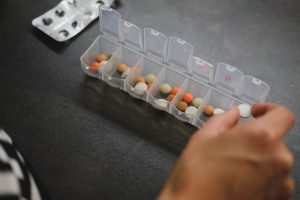Disclaimer: This article was prepared by Liang-Ni Wu in her personal capacity. The views and opinions expressed in this article are the author’s own and do not necessarily reflect the policy or view of Merck KGaA.
Article December 2016
In my last article in October 2016, I used an example to discuss whether efficacy or safety comes first in the aspect of drug development. I would like to share Shyam Krishnan’s response, which well summarizes that pharmaceutical companies are working on “identifying lead molecule and onward development through predetermined steps” where “the efficacy comes first which would be refined later based on safety profile.” Monitoring of the safety of a drug product is a continuous effort, not limited to the clinical development phase and is especially important after the product is brought to the market, where more people/patients are exposed to the drug. Pharmaceutical companies are thus required by authorities in Europe and several other countries to have a pharmacovigilance system in place, when they bring drug products to the market.
A pharmacovigilance system can refer to a system maintained by the regulatory authorities applying to the nations/areas, for example, the European Union (EU) pharmacovigilance system which involves the European Medicines Agency (EMA) and regulatory authorities from EU/European Economic Area (EEA) countries. A pharmacovigilance system can also refer to the system which is set-up and maintained within a company. In this article, I will focus on introducing the pharmacovigilance system within a pharmaceutical company associated with marketed products.
Why is a pharmacovigilance system important for a company?
Pharmacovigilance system is important not only because it is required by certain regulatory authorities, and not only because a company intends to market a drug in EEA. A pharmacovigilance system in the company is a continuous investment to ensure the business in the long run, a science to early detect potential issues and to manage the risks before bigger damages occur, and a professionalism showing that the company takes responsibilities to ensure patient safety.
Imagine that a pharmaceutical company has spent a lot of effort to market a new, promising product. After two years, a patient died from acute renal failure and the product was one of the few (and the only newly marketed drug) the patient took before his death. It was reported on the newspaper that patient died after taking the new product. A lot of enquires come to the company to ask for explanation and the regulatory authority also request for investigation. What data and what evidence can the company give to clarify doubts, and what actions can the company take? Without a pharmacovigilance system in place, how can a company ensure that all safety events related to the use of the product have been reported via the healthcare professionals managed by the company’s sales/promoters, vendors and by collaborating partners? How can the company ensure that all safety information related to this product has been collected, if there is no one in the company to continuously review literature and to check the regulatory authority websites to screen for potential adverse event reports and identify safety issues/reports related to the use of the product? Without collecting all available safety information and without continuous evaluation/assessment/processing of safety reports collected, how can the company conduct analyses to figure out whether and how this product may be associated with a new risk? And in case a new risk is identified, how can the company take proper actions if there are not yet relevant procedures in place and people are not already trained? The word “vigilance” already indicates that pharmacovigilance is a highly-alerted state and very careful action to “watch” for the effects of a drug. And it starts from setting up a pharmacovigilance system.
What is a company’s pharmacovigilance system?
To get the best answer to this question, companies are advised to consider the Module II of the guideline on Good Pharmacovigilance Practices (GVP) which describes about pharmacovigilance system master file (PSMF). PSMF is a typical requirement for market authorization holders in EU, but it also describes the key elements of a pharmacovigilance system inside a pharmaceutical company which is not necessarily EU-specific. An obvious example is the computer system or database used to perform pharmacovigilance activities as a part of the pharmacovigilance system, such as a safety database used to maintain safety information and to generate regulatory reports, conduct signal detection activities, exchange information with partner companies and to perform regulatory reporting. Furthermore, the fundamental elements inside a pharmacovigilance system include:
People is the first key element in the pharmacovigilance system. With no doubt, a company needs to have the right people and resource to work on the relevant activities. If a company has a complete set of standard operating procedures (SOPs) but with no people assigned to these responsibilities, the system simply does not work. In the EU/EEA requirement, one qualified person for pharmacovigilance (QPPV) should be appointed to take responsibilities for the pharmacovigilance system of the company and to oversee pharmacovigilance activities. The criteria of a person to be considered as qualified as EU/EEA QPPV are defined in GVP module I. Of note, QPPV is a completely-different role from the Qualified Person (QP) who ensures product quality and provides certification for each batch before it is released, as defined in EU Good Manufacturing Practice (GMP). Do not get confused by the similar terms!
The company should entitle the QPPV sufficient authority to oversee and to improve the pharmacovigilance system inside the company. The authorities’ request to have a single QPPV in a company also means a single safety contact from the company, in case of urgent need by the authority to contact the company for, for example, emerging safety issues. Regulatory authorities from some countries (inside or outside of EU/EEA) also require a company to appoint a qualified person for pharmacovigilance at the national level, to serve as national contact for safety. The role of EU/EEA QPPV in relation to the national qualified/responsible person (people) for pharmacovigilance should also be defined in the pharmacovigilance system.
Of course, the company cannot (and should not) expect the QPPV to work every day without any break. The QPPV should have a back-up arrangement; the same principle for national qualified/responsible person (people) for pharmacovigilance and all other positions in the company’s pharmacovigilance system. I have learned a rule of three for the back-up arrangement – the company/manager should consider a group of at least three people to back up for each other – one primary responsible person, one primary back-up and a secondary back-up. This is especially useful for arranging important and continuous tasks such as the medical/safety on-call team, or tasks where quality check (QC) is required – one person to perform primary task, the second person to perform QC, and the third to cover either task when one of them is not available. Of course, if there are more than three people in one group, it allows more flexibility and more capacity to handle high peak workloads, although it also means more people to be trained – it is ideal for a team who performs standard tasks such as data entry based on standard conventions.
For companies who do no hold any market authorization in EU/EEA, they are not required to appoint an EU/EEA QPPV. However, for the company to set up a pharmacovigilance system, a “qualified person” to oversee the pharmacovigilance activities within the company is still needed. The definition of “qualified person” without the context of EU/EEA requirement can be discussed. At least, this person should be experienced or well-trained in pharmacovigilance, should understand the applicable pharmacovigilance requirements and should be able to advise the company about necessary actions to take to fulfil the requirements.
Procedures (quality documents)is the second key element in the pharmacovigilance system. If you assign Mr. X to check for regulatory websites every day to screen for potential safety information, but if this role and process is not defined in any procedure, when Mr. X leaves, there can be several outcomes – this task may be handed over to Mr. Y who follows accordingly; it may be continued by Mr. Y but no longer in daily basis as he does not see much information published on the website every time he checks it; it may be handed over but not followed, as Mr. Y has too many new tasks to take over and has to deprioritize the website check; or this task can be simply lost and nobody knows about it after 6 months. Without a written procedure, different person performs a task differently and an important task can be missed when there is a personnel change. To set up a pharmacovigilance system, a company needs to set up SOPs and relevant working procedures to define how adverse events are collected and recorded and how these reports are handled, for example, if there is someone taking care of hotline, if there is someone checking the company website every day to screen for potential adverse event report from consumers, if all employees are checking business emails and phone calls every day to identify potential reports…etc. It would be helpful to write a smart procedure which answers 5W questions – what, who, where, when and how! Let’s say in terms of adverse event collection, the procedures should describe what information is recorded / what questions are asked / what forms are used, who collects, who reviews, who contacts the reporter for questions, and who sends these reports in what format where, by when and how…etc. These procedures written should also match with the structure of the pharmacovigilance team in the company. For example, when a company appoints a qualified person to oversee pharmacovigilance activities in the company, this person and role should appear in the company organizational chart and responsibilities described in the procedures.
Depending on the nature and scale of the company business, different procedures may need to be prepared. A drug importer/wholesaler should have a procedure to handle product recalls; a company who have sales/promoters should have a procedure to deal with the direct communication with healthcare professionals in case of safety concerns of the product; a company with more complete system would also have procedures to define the preparation of safety reports, signal detection, risk management…etc. All pharmaceutical companies should at least have a procedure to identify, collect and handle adverse event reports, and a process to handle emerging safety issues associated with products managed by them.
Training is also a key element to ensure that all personnel in the company is aware of and able to follow the procedures. The importance of training is of no doubt – it is not a secret, but to ensure training is always the pain in the ass for a company. Training is a lengthy and continuous requirement, which is very time-consuming. But training is the only agent to bind procedures to people and bring them to effect. The company should define what will be trained (e.g. SOPs, working procedures, basic pharmacovigilance training, project specific procedures, manuals…etc.) to whom (e.g. all company staff, sales/promoters, vendors…etc.), in what format (self-paced, instructor-led or on-the-job) and the timeline (one time or recurrent, due date…etc.) Lastly, trainings should be properly done and properly documented; do not forget the saying in the industry: document what you have done – without documentation, you have not done it.
Performance measurement and audit, together with quality documents, compose a company’s quality system. Performance measurement helps the company to evaluate how compliant the company is to the standard procedures and to regulatory requirements. A quality system without performance measurement, is like a teacher who gives lectures, assigns homework and gives examinations to students but provides no feedback. With no feedback, the student has no much chance to improve, neither do the employees in the company without performance measurement. If the company aims to be compliant to safety reporting obligations, the company should systematically collect the information about report submission, ensuring that all safety reports submitted by each department and each employee are captured in a database as soon as the report is submitted, and that someone is monitoring for the compliance rate, investigating the reason of low-compliance or delays and to take actions to improve it. Likewise, for all key activities, the company can set up appropriate performance indicators and collect objective data to measure the performance in a transparent way. Regular planning and conduct of pharmacovigilance audit would improve the quality system and the performance of pharmacovigilance activities in the company. Regular audits would also help the company to be inspection-ready. If a company does not have an internal auditor specialized in pharmacovigilance, the company can hire an external pharmacovigilance auditor to conduct such audit.
I admit that performance measurement and internal audits are sensitive topics for employees, as nobody likes to be measured or audited. A healthy and positive attitude of the management team in the company is thus crucial. The company management should let the employees know that the purpose of performance measurement and internal audits is to improve overall quality, ensure patient safety and to provide better product service in the market – it is undesirable if the team prioritizes the performance data over the real value behind the numbers.
Hopefully, the concept of pharmacovigilance system can be understood, especially by manufacturers who already have pharmaceutical quality system in place. The key elements of pharmacovigilance system, like the principles of pharmaceutical quality system / quality system regulations associated with GMP, are in line with the International Organization for Standardization (ISO) standards.




